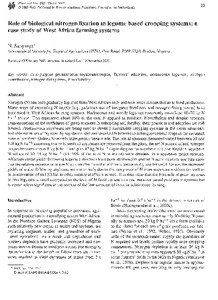| dc.contributor.author | Sanginga, N. |
| dc.date.accessioned | 2019-12-04T11:23:58Z |
| dc.date.available | 2019-12-04T11:23:58Z |
| dc.date.issued | 2003-05 |
| dc.identifier.citation | Sanginga, N. (2003). Role of biological nitrogen fixation in legume based cropping systems; a case study of West Africa farming systems. Plant and Soil, 252(1), 25-39. |
| dc.identifier.issn | 0032-079X |
| dc.identifier.uri | https://hdl.handle.net/20.500.12478/4227 |
| dc.description.abstract | Nitrogen (N) has been gradually depleted from West African soils and now poses serious threats to food production. Many ways of increasing N supply (e.g. judicious use of inorganic fertilizers and nitrogen-fixing plants) have been tried in West African farming systems. Herbaceous and woody legumes commonly contribute 40–70 kg N ha−1 season. This represents about 30% of the total N applied as residues. Nevertheless and despite repeated demonstrations of the usefulness of green manures in enhancing soil fertility, their practices and adoption are still limited. Promiscuous soyabeans are being used to develop sustainable cropping systems in the moist savannah. Reliable estimates of N2 fixed by soyabeans and their residual N benefits to subsequent cereal crops in the savannah zone of southern Guinea have only infrequently been made. The actual amounts measured varied between 38 and 126 kg N ha−1 assuming that only seeds of soyabeans are removed from the plots, the net N accrual of soil nitrogen ranges between minus 8 kg N ha−1 and plus 47 kg N ha−1 depending on the soyabean cultivar. Residual soyabean N values of 10–24 kg N ha−1 (14–36% of the total N in maize) were obtained in a soyabean-maize rotation. Although cereal yields following legume cultivation have been attributed to greater N accumulation, our data show that the relative increase in maize N was smaller than the relative increase in dry-matter yield. Hence, the increased yields of maize following soybeans are not entirely due to the carry-over of N from soyabean residues (as well as to conservation of soil N) but to other rotational effects as well. It is thus clear that the Nbenefit of Grain Legumes to non-legumes is small compared to the level of N fertilizer use in more intensive cereal production systems but is nevertheless significant in the context of the low amounts of input in subsistence farming. |
| dc.language.iso | en |
| dc.subject | Soybeans |
| dc.subject | Cowpeas |
| dc.subject | Herbaceous |
| dc.subject | Legumes |
| dc.subject | Nitrogen |
| dc.subject | Nitrogen Fixing Trees |
| dc.title | Role of biological nitrogen fixation in legume based cropping systems; a case study of West Africa farming systems |
| dc.type | Journal Article |
| dc.type | Journal Article |
| dc.description.version | Peer Review |
| cg.contributor.affiliation | International Institute of Tropical Agriculture |
| cg.coverage.region | Africa |
| cg.coverage.region | West Africa |
| cg.coverage.country | Nigeria |
| cg.isijournal | ISI Journal |
| cg.authorship.types | CGIAR single centre |
| cg.iitasubject | Grain Legumes |
| cg.accessibilitystatus | Limited Access |
| local.dspaceid | 99793 |
| cg.identifier.doi | https://doi.org/10.1023/A:1024192604607 |

